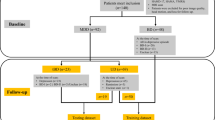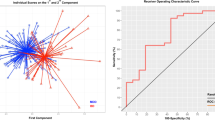Abstract
It is known that both bipolar disorder (BD) and major depressive disorder (MDD) can manifest depressive symptoms, especially in the early phase of illness. Therefore, discriminating BD from MDD is a major clinical challenge due to the absence of biomarkers. Feature selection is especially important in neuroimaging applications, yet high feature dimensions, low sample size and poor model understanding present huge challenges. Here we developed an advanced feature selection algorithm, “SVM-FoBa”, which enables adaptive selection of informative feature subsets from high dimensional resting-state functional connectives (rsFC) data. By comparing SVM-FoBa with conventional feature selection methods on several public biomedical data sets, the proposed method was proven to be increasingly superior as the feature dimension became high. When applying SVM-FoBa to brain data, with 38 significant rsFCs chosen from 6670 in total, an 88 % classification accuracy between BD and MDD was achieved using leave-one-out cross-validation. Further, by conducting weight analysis, the most discriminative FCs were revealed, providing which adds to our understanding of functional deficits and may serve as potential biomarkers for mood disorders.


Similar content being viewed by others
References
DiLuca, M., & Olesen, J. (2014). The cost of brain diseases: a burden or a challenge? Neuron, 82(6), 1205–1208.
Cuellar, A. K., Johnson, S. L., & Winters, R. (2005). Distinctions between bipolar and unipolar depression. Clinical Psychology Review, 25(3), 307–339.
de Almeida, J. R. C., & Phillips, M. L. (2013). Distinguishing between unipolar depression and bipolar depression: current and future clinical and neuroimaging perspectives. Biological Psychiatry, 73(2), 111–118.
Hirschfeld, R. M., & Vornik, L. A. (2005). Bipolar disorder--costs and comorbidity. [Review]. The American Journal of Managed Care, 11(3 Suppl), S85–S90.
Kupfer, D. J. (2005). The increasing medical burden in bipolar disorder. JAMA, 293(20), 2528–2530. doi:10.1001/jama.293.20.2528.
Grotegerd, D., Suslow, T., Bauer, J., Ohrmann, P., Arolt, V., Stuhrmann, A., et al. (2013). Discriminating unipolar and bipolar depression by means of fMRI and pattern classification: a pilot study. [Research Support, Non-U.S. Gov’t]. European Archives of Psychiatry and Clinical Neuroscience, 263(2), 119–131. doi:10.1007/s00406-012-0329-4.
Cortes, C., & Vapnik, V. (1995). Support-Vector Networks. Machine Learning, 20(3), 273–297. doi:10.1023/A:1,022,627,411,411.
Zhang, T. Adaptive forward-backward greedy algorithm for sparse learning with linear models. In Advances in Neural Information Processing Systems, 2009 (pp. 1921–1928)
Jie, N.-F., Ma, X.-Y., Zhu, M.-H., Osuch, E., Wammes, M., Theberge, J., et al. (2015). Discriminating Bipolar Disorder From Major Depression Based on SVM-FoBa: Efficient Feature Selection With Multimodal Brain Imaging Data. IEEE Transactions on Autonomous Mental Development(99), doi:10.1109/TAMD.2015.2440298.
Chang, C.-C., & Lin, C.-J. (2011). LIBSVM: a library for support vector machines. ACM Transactions on Intelligent Systems and Technology (TIST), 2(3), 27.
Tsanas, A., Little, M., Fox, C., & Ramig, L. O. (2014). Objective automatic assessment of rehabilitative speech treatment in Parkinson’s disease. IEEE Transactions on Neural Systems and Rehabilitation Engineering, 22(1), 181–190.
Alon, U., Barkai, N., Notterman, D. A., Gish, K., Ybarra, S., Mack, D., et al. (1999). Broad patterns of gene expression revealed by clustering analysis of tumor and normal colon tissues probed by oligonucleotide arrays. Proceedings of the National Academy of Sciences, 96(12), 6745–6750.
Golub, T. R., Slonim, D. K., Tamayo, P., Huard, C., Gaasenbeek, M., Mesirov, J. P., et al. (1999). Molecular classification of cancer: class discovery and class prediction by gene expression monitoring. Science, 286(5439), 531–537.
Yan, C., & Zang, Y. (2010). DPARSF: a MATLAB toolbox for “pipeline” data analysis of resting-state fMRI. Frontiers in Systems Neuroscience, 4.
Tzourio-Mazoyer, N., Landeau, B., Papathanassiou, D., Crivello, F., Etard, O., Delcroix, N., et al. (2002). Automated anatomical labeling of activations in SPM using a macroscopic anatomical parcellation of the MNI MRI single-subject brain. NeuroImage, 15(1), 273–289.
Rakotomamonjy, A. (2003). Variable selection using svm based criteria. The Journal of Machine Learning Research, 3, 1357–1370.
Duda, R. O., Hart, P. E., & Stork, D. G. (2012). Pattern classification: John Wiley & Sons.
Guyon, I., Weston, J., Barnhill, S., & Vapnik, V. (2002). Gene selection for cancer classification using support vector machines. Machine Learning, 46(1–3), 389–422.
Xia, M., Wang, J., & He, Y. (2013). BrainNet Viewer: a network visualization tool for human brain connectomics. [Research Support, Non-U.S. Gov’t]. PloS One, 8(7), e68910. doi:10.1371/journal.pone.0068910.
Roweis, S. T., & Saul, L. K. (2000). Nonlinear dimensionality reduction by locally linear embedding. Science, 290(5500), 2323–2326.
Sollich, P. (2002). Bayesian methods for support vector machines: Evidence and predictive class probabilities. Machine Learning, 46(1–3), 21–52.
Zhang, Z., & Jordan, M. I. (2012). Bayesian multicategory support vector machines. arXiv preprint arXiv:1206.6863.
Davis, L. (1991). Handbook of genetic algorithms (Vol. 115): Van Nostrand Reinhold New York.
Frohlich, H., Chapelle, O., & Scholkopf, B. Feature selection for support vector machines by means of genetic algorithm. In Tools with Artificial Intelligence, 2003. Proceedings. 15th IEEE International Conference on, 2003 (pp. 142–148): IEEE
Skiena, S. S. (1998). The algorithm design manual: Text (Vol. 1): Springer Science & Business Media.
Haynes, J. D., & Rees, G. (2006). Decoding mental states from brain activity in humans. [Research Support, Non-U.S. Gov’t Review]. Nat Rev. Neurosci, 7(7), 523–534. doi:10.1038/nrn1931.
Pizzagalli, D. A., Holmes, A. J., Dillon, D. G., Goetz, E. L., Birk, J. L., Ryan Bogdan, A., et al. (2009). Reduced caudate and nucleus accumbens response to rewards in unmedicated individuals with major depressive disorder. The American Journal of Psychiatry, 166(6), 702–710.
Malhi, G. S., Lagopoulos, J., Sachdev, P., Mitchell, P. B., Ivanovski, B., & Parker, G. B. (2004). Cognitive generation of affect in hypomania: an fMRI study. Bipolar Disorders, 6(4), 271–285.
Pompei, F., Dima, D., Rubia, K., Kumari, V., & Frangou, S. (2011). Dissociable functional connectivity changes during the Stroop task relating to risk, resilience and disease expression in bipolar disorder. NeuroImage, 57(2), 576–582.
Konarski, J. Z., McIntyre, R. S., Grupp, L. A., & Kennedy, S. H. (2005). Is the cerebellum relevant in the circuitry of neuropsychiatric disorders? Journal of Psychiatry and Neuroscience, 30(3), 178.
DelBello, M. P., Strakowski, S. M., Zimmerman, M. E., Hawkins, J. M., & Sax, K. W. (1999). MRI analysis of the cerebellum in bipolar disorder: a pilot study. Neuropsychopharmacology, 21(1), 63–68.
Kim, D., Byul Cho, H., Dager, S. R., Yurgelun-Todd, D. A., Yoon, S., Lee, J. H., et al. (2013). Posterior cerebellar vermal deficits in bipolar disorder. Journal of Affective Disorders, 150(2), 499–506.
Cecil, K. M., DelBello, M. P., Sellars, M. C., & Strakowski, S. M. (2003). Proton magnetic resonance spectroscopy of the frontal lobe and cerebellar vermis in children with a mood disorder and a familial risk for bipolar disorders. Journal of Child and Adolescent Psychopharmacology, 13(4), 545–555.
Strakowski, S. M., Adler, C. M., & DelBello, M. P. (2002). Volumetric MRI studies of mood disorders: do they distinguish unipolar and bipolar disorder? Bipolar Disorders, 4(2), 80–88.
Mills, N. P., DelBello, M. P., Adler, C. M., & Strakowski, S. M. (2005). MRI analysis of cerebellar vermal abnormalities in bipolar disorder. The American Journal of Psychiatry, 162(8), 1530–1532.
Shah, S., Doraiswamy, P., Husain, M., Escalona, P., Na, C., Figiel, G., et al. (1992). Posterior fossa abnormalities in major depression: a controlled magnetic resonance imaging study. Acta Psychiatrica Scandinavica, 85(6), 474–479.
Dolan, R., Bench, C. J., Brown, R., Scott, L. C., Friston, K., & Frackowiak, R. (1992). Regional cerebral blood flow abnormalities in depressed patients with cognitive impairment. Journal of Neurology, Neurosurgery & Psychiatry, 55(9), 768–773.
Sweeney, J. A., Strojwas, M. H., Mann, J. J., & Thase, M. E. (1998). Prefrontal and cerebellar abnormalities in major depression: evidence from oculomotor studies. Biological Psychiatry, 43(8), 584–594.
Just, M. A., Carpenter, P. A., Keller, T. A., Eddy, W. F., & Thulborn, K. R. (1996). Brain activation modulated by sentence comprehension. Science, 274(5284), 114–116.
Farrow, T. F., Zheng, Y., Wilkinson, I. D., Spence, S. A., Deakin, J. W., Tarrier, N., et al. (2001). Investigating the functional anatomy of empathy and forgiveness. Neuroreport, 12(11), 2433–2438.
Derntl, B., Seidel, E.-M., Schneider, F., & Habel, U. (2012). How specific are emotional deficits? A comparison of empathic abilities in schizophrenia, bipolar and depressed patients. Schizophrenia Research, 142(1), 58–64.
Phillips, M., Travis, M., Fagiolini, A., & Kupfer, D. (2008). Medication effects in neuroimaging studies of bipolar disorder. American Journal of Psychiatry, 165(3), 313–320.
Acknowledgments
This work was partially supported by “100 Talents Plan” of Chinese Academy of Sciences (to J. Sui); Chinese National Science Foundation No. 81471367, the State High-Tech Development Plan (863), grant No. 2015AA020513 (to J. Sui); and the Strategic Priority Research Program of the Chinese Academy of Sciences, grant No. XDB02060005 (to J. Sui); PhD Research Startup Foundation of Jiangxi Normal University, grant No. 6247 (to M.-H. Zhu); National Institutes of Health grants R01EB006841, and P20GM103472 (to V.D. Calhoun); the Lawson Health Research Institute, grant No. LHR D1374 (to E.A. Osuch); and a Pfizer Independent Investigator Award, grant No. WS2249136 (to E.A. Osuch).
Author information
Authors and Affiliations
Corresponding authors
Rights and permissions
About this article
Cite this article
Jie, NF., Osuch, E.A., Zhu, MH. et al. Discriminating Bipolar Disorder from Major Depression using Whole-Brain Functional Connectivity: a Feature Selection Analysis with SVM-FoBa Algorithm. J Sign Process Syst 90, 259–271 (2018). https://doi.org/10.1007/s11265-016-1159-9
Received:
Revised:
Accepted:
Published:
Issue Date:
DOI: https://doi.org/10.1007/s11265-016-1159-9




